Starting from:
$12.95
Home
Famous Crimes
Leopold and Loeb Trial - Bobby Franks Murder Case Documents and Histories - Download
Leopold and Loeb Trial - Bobby Franks Murder Case Documents and Histories - Download
Leopold and Loeb Trial - Bobby Franks Murder Case Documents and Histories
4,614 pages of court documents, trial transcripts, and histories covering the trial of Nathan F. Leopold and Richard A. Loeb and the murder of Bobby Franks.
One of several incidents contemporarily referred to as the "Crime of the Century," Nathan Leopold and Richard Loeb, known as "Babe" and "Dickie" to their friends, murdered 14 year-old Bobby Franks. Seven months of planning by two geniuses resulted in a relatively simple and grotesque crime. Franks' body and a pair of eye glasses with a distinctive feature traceable to Leopold were found in less than 12 hours. The uniqueness of two wealthy, highly intelligent young men committing a heinous murder for sport, made this incident stand out from the other 518 homicides in Cook County in 1924. Leopold was 18 and Loeb was 17 when they were arrested. Leopold, who at the time was the youngest person to graduate from the University of Chicago, was a law student at the University of Chicago, and was transfering to Harvard Law School. Loeb was the youngest graduate ever from the University of Michigan.
A Chicago Police Department office file card on the murder puts the events in simple terms, "Case 6034 Franks, Robt. - Age 13 - His nude body found in culvert at 118th St. nd Penna R.R. where he was hidden by Richard Loeb and Nathan J. Leopold. The two were indicted on June 5th after confessing to the murder giving as their motive that it was an 'experiment in sensation' as well as the $10,000.00 they asked as ransom. 8 Dist. 9/10/24 Each sentenced to Life term in Joliet Pen. On the Murder charge and 99 years for kidnapping. - Caverly."
Public and media odium towards the pair and interest in the decadent nature of the crime fueled widespread attention to, and the promulgation of the details of the murder of Franks and its aftermath.
Late in the spring of 1924 Leopold and Loeb grew bored with the series of petty crimes they had committed. They decided that they should commit the perfect crime which the Friedrich Nietzsche devotees believed would confirm their status as "supermen." The pair spent the next seven months planning abducting and disposing of a boy. They would ask for a ransom as a way to hide the fact that the perpetrators of the crime were wealthy. They constructed a scheme to collect the ransom without getting caught, by giving the person who would drop the money a long series of instructions, to be given one at a time by telephone. They decided that the murder weapon should be a chisel. They spent the next several weeks searching for a victim.
The misfortune of their selection fell upon 14-year-old Bobby Franks, the son of wealthy Chicago watch manufacturer Jacob Franks, and Loeb's second cousin. While Franks was walking home from the Harvard School for Boys, he was approached by Leopold and Loeb driving a car rented under an assumed named, and was offered a ride home. Only two blocks from his house, Bobby declined the offer. Loeb, who had played tennis with Bobby at the Loeb's family's home a few days earlier, told Bobby he wanted to discuss the tennis racket Bobby was using. Bobby entered the car, where he was beaten with a chisel and gagged.
Frank's body was taken to a culvert along the Pennsylvania Railroad tracks approximately 25 miles north of Chicago near Wolf Lake in Hammond, Indiana. Hydrochloric acid was poured on Franks to obscure his identity.
After returning to Chicago, where the search for the missing boy had already begun, Leopold called Booby Frank's mother, identified himself as "George Johnson", and told her that her son had been kidnapped and instructions would follow. A ransom note arrived in the mail the next morning and Leopold called with the first set of instructions. But the Franks family member who took the call forgot the address of the store where the next set of instructions was to be communicated. However, the charade ended when the family was soon after informed that Bobby's body had been found.
Police found a pair of eyeglasses near the body. Though common in prescription and frame, they were equipped with an unusual hinge mechanism purchased by only three customers in Chicago; one was Nathan Leopold. When questioned, Leopold offered the possibility that his glasses might have dropped out of his pocket during a bird-watching trip. Police soon found the typewriter used to type the ransom note. During questioning they claimed that on the night of the murder, they had picked up two women, "Edna" and "May", in Chicago, using Leopold's car, then dropped them off sometime later near a golf course without learning their last names. However, Leopold's chauffeur told police that he was repairing Leopold's car that night, when the men claimed to have used it.
The first to crack under questioning by the Chicago Police Department's top homicide detectives was Loeb. He confessed, but insisted that it was Leopold's idea, that Leopold killed Franks; Loeb claimed to have just driven the car. Leopold soon gave his own confession in which he was the driver and Loeb the murderer.
The Loeb family hired Clarence Darrow, one of the most renowned criminal defense lawyers in the country to defend both men. This trial and the Scopes Monkey trial the next year would become Darrow's two most famous court room casmpaignss. The first planned defense was to claim innocence by reason of insanity. Acknowledging the likely outcome, conviction and execution, Darrow changed strategies. The pair would plead guilty, not seek a jury trial, and hoped that Cook County Circuit Court Judge John R. Caverly would give life sentences instead of imposing the death penalty.
With a guilty plea and without a jury, the proceedings moved to a sentencing hearing. During the hearing the state called more than one hundred witnesses to document the crime and Leopold and Loeb's guilt. Darrow presented testimony from psychiatrists, at the time commonly referred to as "alienists", giving theories that would mitigate the guilt of "the boys," the term Darrow would use to refer to the confessed killers. At the end of the hearing Darrow gave a 12 hour speech which some credit with saving the pair from hanging.
Leopold and Loeb were initially sent to Joliet Prison to serve their life sentences. There they kept in contact. Leopold was transferred to Statesville Penitentiary, and Loeb was soon transferred there as well, where they taught classes in the prison school.
On January 28, 1936 a fellow inmate James E. Day, Loeb's former cellmate, while in a shower in Statesville prison, used a straight razor to inflict 50 cuts to Loeb, who later died from his wounds. Day, who sustained no injuries, claimed that Loeb had made a sexual advance and he was defending himself. A prison inquiry found that Day acted in self-defense. Day, who was serving a nine-year sentence for larceny, was released from prison in 1942.
Characterized as a model prisoner, Leopold spent 33 years in prison before being paroled in 1958 to a job in Puerto Rico. He was released from parole in 1963 and died of a heart attack in 1971.
The material in this collection includes:
The typed confessions of both Leopold and Loeb
Cook County Grand Jury Witness List
Cook County Grand Jury papers recording the indictment of Leopold and Loeb
Report of the Psychiatric examination of Nathan F. Leopold conducted by psychiatrists at the behest of Leopold's family and lawyers
Report of the Psychiatric examination of Richard A. Loeb conducted by psychiatrists at the behest of Loeb's family and lawyers
Trial transcripts of court proceeding from July 23 to September 9, 1924. Please note that pages 3937 to 4115 are missing because Clarence Darrow after the trial requested the original official transcript containing his closing argument and never returned those pages. Transcripts of his closing arguments can be found in other material listed below. The full text of the speech can be found in "The Loeb-Leopold Case" by Alvin V. Sellers, pp. 118- 232, "Attorney Darrow's Plea for Mercy and Prosecutor Robert E. Crowes Demand for the Death Penalty in the Leob-Leopold Case, the Crime of the Century," and "Clarence Darrow's Plea in Defense of Loeb and Leopold."
Sentencing document recording Judge John R. Calvery's sentencing of the murderers
Books included in this collection:
Clarence Darrow's "Plea for Mercy and Prosecutor Crowe's Demand for the Death Penalty"
From the book's introduction:
"The intense national interest displayed in the Franks Case, especially in the final arguments of Mr. Darrow and Mr. Crowe, and the wide demand for their speeches has led to the publication of this book.
It is peculiar of this particular case that all types of minds were interested in the case from some angle. By some strange alignment of the circumstances in the case the question of capital punishment became an issue. Perhaps this was due more or less to the social position of the defendants and the well-known philosophy of the chief counsel, Mr. Darrow. In any event, the case is interesting from that standpoint and will perhaps be the basis of future arguments on that endless controversy. From this standpoint we consider the final arguments educational and this constitutes our only reason for publishing these speeches.
We are not seeking to exploit the sordidness of the case and have kept such details out of both the final arguments and the facts of the case."
The Loeb-Leopold Case by Alvin V. Sellers
Full title: The Loeb-Leopold Case with Excerpts from the Evidence of the Alienists and Including the Arguments to the Court by Counsel for the People and the Defense
Contains the full text of the Darrow's closing arguments, statements of the prosecutors and Darrow's associate attorneys, and excerpts from the psychiatrists' reports.
Chapter headings include: The Loeb-Leopold Case; Speech of Thomas Marshall; Speech of Joseph P. Savage; Speech of Walter Bachrach; Speech of Clarence Darrow; Speech of Benjamin C. Bachrach; Speech of Robert E. Crowe.
Leopold and Loeb, A Psychiatric-Psychological Study (1924) by Maurice Urstein
A re-arrangement of the author's descriptions of what he terms catatonia (at the time what Bleuler terms schizophrenia) is given from his previous monographic publications and incidents from the court-room behavior and developmental life of the two murderers used to show how they were presumably driven by the same psychosis.
Crime; Its Causes and Treatment (1922) by Clarence Darrow
Abstract: This book comes from the reflections and experience of more than forty years spent in court. Aside from the practice of my profession, the topics I have treated are such as have always held my interest and inspired a taste for books that discuss the human machine with its manifestations and the causes of its varied activity. I have endeavored to present the latest scientific thought and investigation bearing upon the question of human conduct. I do not pretend to be an original investigator, nor an authority on biology, psychology or philosophy. I have simply been a student giving the subject such attention as I could during a fairly busy life. No doubt some of the scientific conclusions stated are still debatable and may finally be rejected. The scientific mind holds opinions tentatively and is always ready to reexamine, modify or discard as new evidence comes to light.
Chicago Police Department Report for 1924
The Chicago PD's statistically inclined report on crime in Chicago for 1924, a year with one of the highest crime rates in the history of Chicago.
Resolved: That Capital Punishment is a Wise Public Policy Debate with Clarence Darrow - Negative and Judge Alfred J. Talley - Affirmative (1924)
The main content of this publication is a transcript of a debate between Judge Talley of the New York Court of General Sessions and Clarence Darrow. Contains a foreword by Warden Lewis E. Lawes of Sing Sing Prison. The debate came about because Judge Talley sharply criticized Darrow for making excuses for crime.
The Plea of Clarence Darrow, August 22nd, 23rd & 25th, In Defense of Richard Loeb and Nathan Leopold, Jr., on Trial For Murder By Ralph Fletcher Seymour
Journal articles included in this collection:
The Constitutional Review October 1922 - Book review of Crime; Its Causes and Treatment by Clarence Darrow
The Journal of Criminal Law and Criminology (volume 15, pp. pp. 341-43(1924)) Abstract: To Abolish Partisanship of Expert Witnesses, as Illustrated in the Loeb - Leopold Case, by John H. Wigmore. Professor Wigmore strongly criticizes the use of expert witnesses in the Leopold and Loeb trial and in trials in general. He was particularly disturbed by the defense's use of the nicknames "Dickie" and "Babe" in referring to the defendants because it was calculated to influence the judge. To Wigmore this reflected very badly on the medical experts and "The whole evil of expert partisanship is exemplified in this action of these eminent gentlemen." He believed that experts called by each party are obviously biased in favor of that party. The solution is to have the court call the experts to testify. Wigmore was the dean of Northwestern Law School from 1901 to 1929 and the author of the very influential "Wigmore on Evidence" treatise.
Journal of Criminal Law and Criminology Volume 15 Issue 3 Article 4 1925 - Loeb-Leopold Murder of Franks in Chicago May 21 1924
Journal of Criminal Law and Criminology Volume 15 Issue 3 Article 8 1925 - Loeb-Leopold Case by Harry Olson
The Outlook, October 10, 1928 - Loeb and Leopold
True Detective Mysteries, August 1930 - The complete issue of True Detective August 1930 containing an article on the murder.
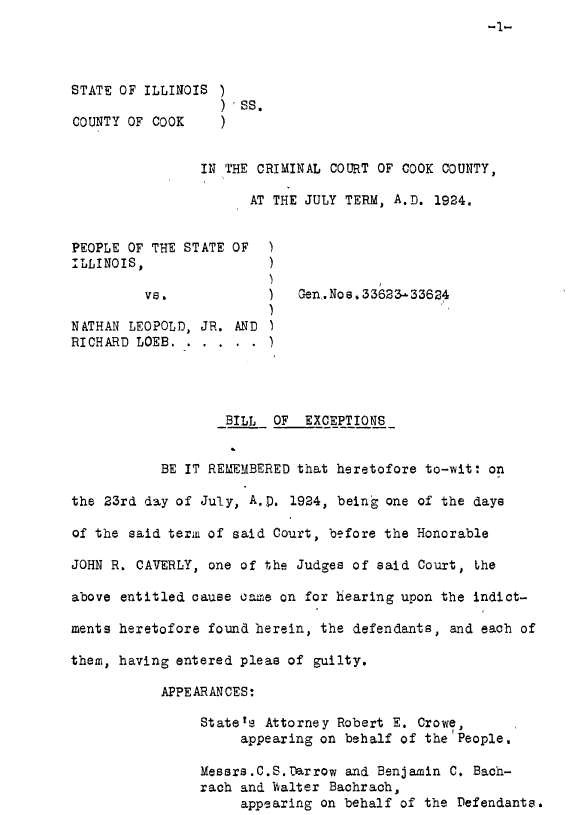
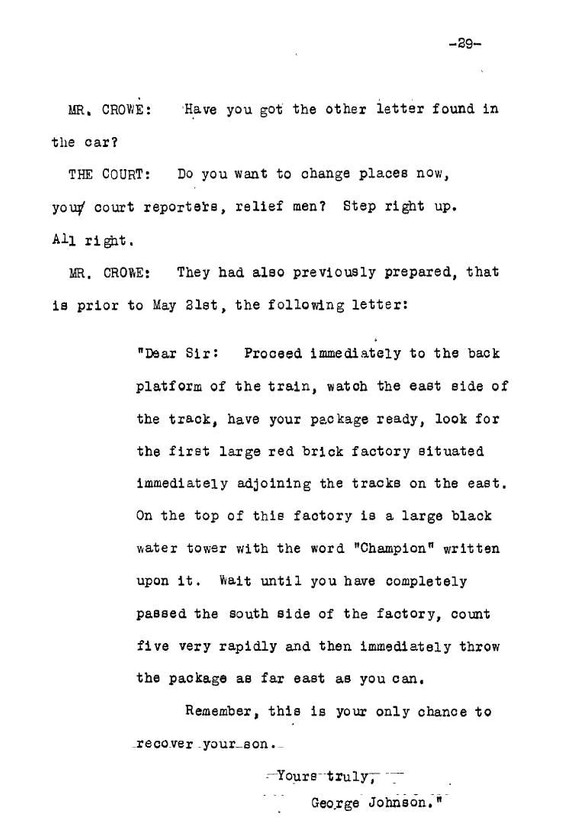

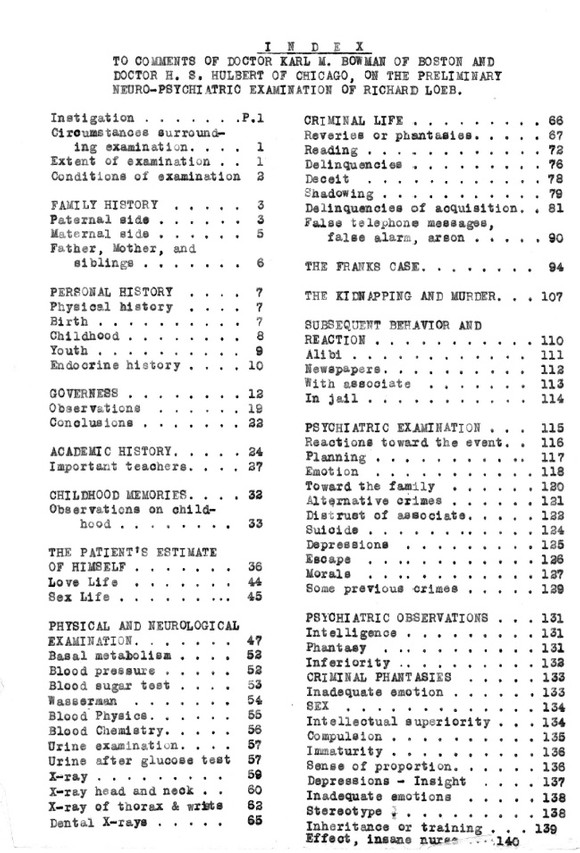
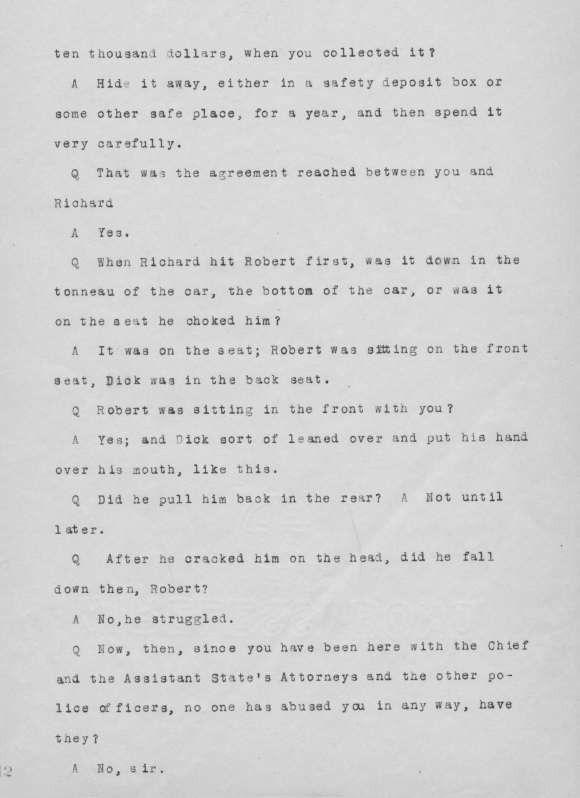

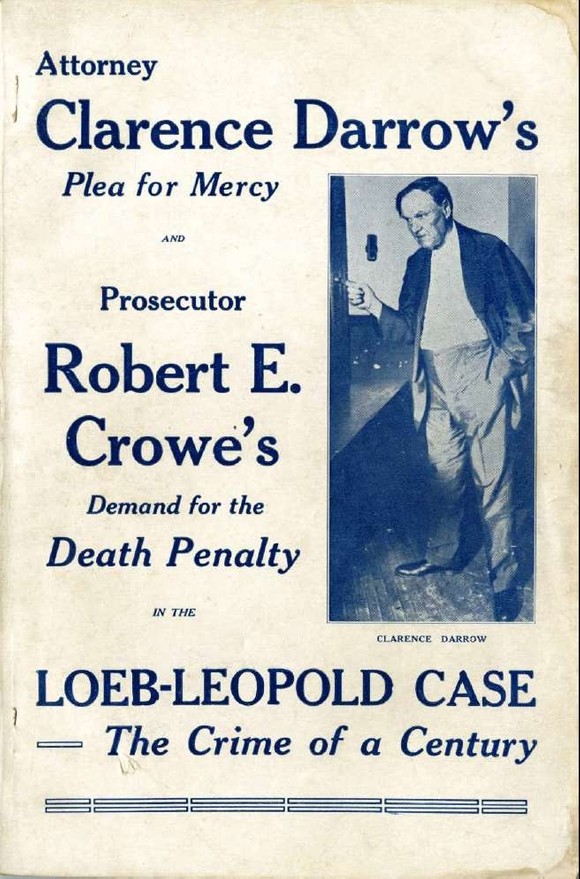
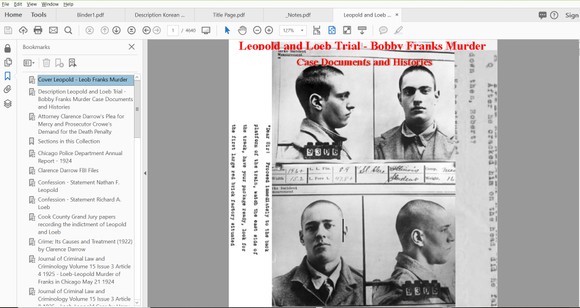
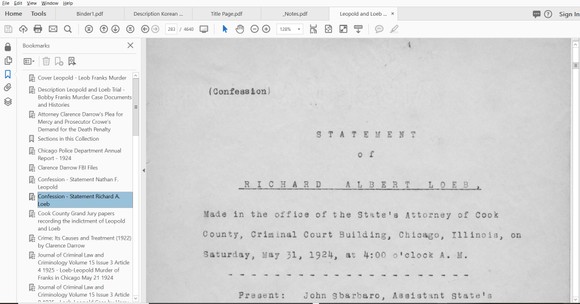

4,614 pages of court documents, trial transcripts, and histories covering the trial of Nathan F. Leopold and Richard A. Loeb and the murder of Bobby Franks.
One of several incidents contemporarily referred to as the "Crime of the Century," Nathan Leopold and Richard Loeb, known as "Babe" and "Dickie" to their friends, murdered 14 year-old Bobby Franks. Seven months of planning by two geniuses resulted in a relatively simple and grotesque crime. Franks' body and a pair of eye glasses with a distinctive feature traceable to Leopold were found in less than 12 hours. The uniqueness of two wealthy, highly intelligent young men committing a heinous murder for sport, made this incident stand out from the other 518 homicides in Cook County in 1924. Leopold was 18 and Loeb was 17 when they were arrested. Leopold, who at the time was the youngest person to graduate from the University of Chicago, was a law student at the University of Chicago, and was transfering to Harvard Law School. Loeb was the youngest graduate ever from the University of Michigan.
A Chicago Police Department office file card on the murder puts the events in simple terms, "Case 6034 Franks, Robt. - Age 13 - His nude body found in culvert at 118th St. nd Penna R.R. where he was hidden by Richard Loeb and Nathan J. Leopold. The two were indicted on June 5th after confessing to the murder giving as their motive that it was an 'experiment in sensation' as well as the $10,000.00 they asked as ransom. 8 Dist. 9/10/24 Each sentenced to Life term in Joliet Pen. On the Murder charge and 99 years for kidnapping. - Caverly."
Public and media odium towards the pair and interest in the decadent nature of the crime fueled widespread attention to, and the promulgation of the details of the murder of Franks and its aftermath.
Late in the spring of 1924 Leopold and Loeb grew bored with the series of petty crimes they had committed. They decided that they should commit the perfect crime which the Friedrich Nietzsche devotees believed would confirm their status as "supermen." The pair spent the next seven months planning abducting and disposing of a boy. They would ask for a ransom as a way to hide the fact that the perpetrators of the crime were wealthy. They constructed a scheme to collect the ransom without getting caught, by giving the person who would drop the money a long series of instructions, to be given one at a time by telephone. They decided that the murder weapon should be a chisel. They spent the next several weeks searching for a victim.
The misfortune of their selection fell upon 14-year-old Bobby Franks, the son of wealthy Chicago watch manufacturer Jacob Franks, and Loeb's second cousin. While Franks was walking home from the Harvard School for Boys, he was approached by Leopold and Loeb driving a car rented under an assumed named, and was offered a ride home. Only two blocks from his house, Bobby declined the offer. Loeb, who had played tennis with Bobby at the Loeb's family's home a few days earlier, told Bobby he wanted to discuss the tennis racket Bobby was using. Bobby entered the car, where he was beaten with a chisel and gagged.
Frank's body was taken to a culvert along the Pennsylvania Railroad tracks approximately 25 miles north of Chicago near Wolf Lake in Hammond, Indiana. Hydrochloric acid was poured on Franks to obscure his identity.
After returning to Chicago, where the search for the missing boy had already begun, Leopold called Booby Frank's mother, identified himself as "George Johnson", and told her that her son had been kidnapped and instructions would follow. A ransom note arrived in the mail the next morning and Leopold called with the first set of instructions. But the Franks family member who took the call forgot the address of the store where the next set of instructions was to be communicated. However, the charade ended when the family was soon after informed that Bobby's body had been found.
Police found a pair of eyeglasses near the body. Though common in prescription and frame, they were equipped with an unusual hinge mechanism purchased by only three customers in Chicago; one was Nathan Leopold. When questioned, Leopold offered the possibility that his glasses might have dropped out of his pocket during a bird-watching trip. Police soon found the typewriter used to type the ransom note. During questioning they claimed that on the night of the murder, they had picked up two women, "Edna" and "May", in Chicago, using Leopold's car, then dropped them off sometime later near a golf course without learning their last names. However, Leopold's chauffeur told police that he was repairing Leopold's car that night, when the men claimed to have used it.
The first to crack under questioning by the Chicago Police Department's top homicide detectives was Loeb. He confessed, but insisted that it was Leopold's idea, that Leopold killed Franks; Loeb claimed to have just driven the car. Leopold soon gave his own confession in which he was the driver and Loeb the murderer.
The Loeb family hired Clarence Darrow, one of the most renowned criminal defense lawyers in the country to defend both men. This trial and the Scopes Monkey trial the next year would become Darrow's two most famous court room casmpaignss. The first planned defense was to claim innocence by reason of insanity. Acknowledging the likely outcome, conviction and execution, Darrow changed strategies. The pair would plead guilty, not seek a jury trial, and hoped that Cook County Circuit Court Judge John R. Caverly would give life sentences instead of imposing the death penalty.
With a guilty plea and without a jury, the proceedings moved to a sentencing hearing. During the hearing the state called more than one hundred witnesses to document the crime and Leopold and Loeb's guilt. Darrow presented testimony from psychiatrists, at the time commonly referred to as "alienists", giving theories that would mitigate the guilt of "the boys," the term Darrow would use to refer to the confessed killers. At the end of the hearing Darrow gave a 12 hour speech which some credit with saving the pair from hanging.
Leopold and Loeb were initially sent to Joliet Prison to serve their life sentences. There they kept in contact. Leopold was transferred to Statesville Penitentiary, and Loeb was soon transferred there as well, where they taught classes in the prison school.
On January 28, 1936 a fellow inmate James E. Day, Loeb's former cellmate, while in a shower in Statesville prison, used a straight razor to inflict 50 cuts to Loeb, who later died from his wounds. Day, who sustained no injuries, claimed that Loeb had made a sexual advance and he was defending himself. A prison inquiry found that Day acted in self-defense. Day, who was serving a nine-year sentence for larceny, was released from prison in 1942.
Characterized as a model prisoner, Leopold spent 33 years in prison before being paroled in 1958 to a job in Puerto Rico. He was released from parole in 1963 and died of a heart attack in 1971.
The material in this collection includes:
The typed confessions of both Leopold and Loeb
Cook County Grand Jury Witness List
Cook County Grand Jury papers recording the indictment of Leopold and Loeb
Report of the Psychiatric examination of Nathan F. Leopold conducted by psychiatrists at the behest of Leopold's family and lawyers
Report of the Psychiatric examination of Richard A. Loeb conducted by psychiatrists at the behest of Loeb's family and lawyers
Trial transcripts of court proceeding from July 23 to September 9, 1924. Please note that pages 3937 to 4115 are missing because Clarence Darrow after the trial requested the original official transcript containing his closing argument and never returned those pages. Transcripts of his closing arguments can be found in other material listed below. The full text of the speech can be found in "The Loeb-Leopold Case" by Alvin V. Sellers, pp. 118- 232, "Attorney Darrow's Plea for Mercy and Prosecutor Robert E. Crowes Demand for the Death Penalty in the Leob-Leopold Case, the Crime of the Century," and "Clarence Darrow's Plea in Defense of Loeb and Leopold."
Sentencing document recording Judge John R. Calvery's sentencing of the murderers
Books included in this collection:
Clarence Darrow's "Plea for Mercy and Prosecutor Crowe's Demand for the Death Penalty"
From the book's introduction:
"The intense national interest displayed in the Franks Case, especially in the final arguments of Mr. Darrow and Mr. Crowe, and the wide demand for their speeches has led to the publication of this book.
It is peculiar of this particular case that all types of minds were interested in the case from some angle. By some strange alignment of the circumstances in the case the question of capital punishment became an issue. Perhaps this was due more or less to the social position of the defendants and the well-known philosophy of the chief counsel, Mr. Darrow. In any event, the case is interesting from that standpoint and will perhaps be the basis of future arguments on that endless controversy. From this standpoint we consider the final arguments educational and this constitutes our only reason for publishing these speeches.
We are not seeking to exploit the sordidness of the case and have kept such details out of both the final arguments and the facts of the case."
The Loeb-Leopold Case by Alvin V. Sellers
Full title: The Loeb-Leopold Case with Excerpts from the Evidence of the Alienists and Including the Arguments to the Court by Counsel for the People and the Defense
Contains the full text of the Darrow's closing arguments, statements of the prosecutors and Darrow's associate attorneys, and excerpts from the psychiatrists' reports.
Chapter headings include: The Loeb-Leopold Case; Speech of Thomas Marshall; Speech of Joseph P. Savage; Speech of Walter Bachrach; Speech of Clarence Darrow; Speech of Benjamin C. Bachrach; Speech of Robert E. Crowe.
Leopold and Loeb, A Psychiatric-Psychological Study (1924) by Maurice Urstein
A re-arrangement of the author's descriptions of what he terms catatonia (at the time what Bleuler terms schizophrenia) is given from his previous monographic publications and incidents from the court-room behavior and developmental life of the two murderers used to show how they were presumably driven by the same psychosis.
Crime; Its Causes and Treatment (1922) by Clarence Darrow
Abstract: This book comes from the reflections and experience of more than forty years spent in court. Aside from the practice of my profession, the topics I have treated are such as have always held my interest and inspired a taste for books that discuss the human machine with its manifestations and the causes of its varied activity. I have endeavored to present the latest scientific thought and investigation bearing upon the question of human conduct. I do not pretend to be an original investigator, nor an authority on biology, psychology or philosophy. I have simply been a student giving the subject such attention as I could during a fairly busy life. No doubt some of the scientific conclusions stated are still debatable and may finally be rejected. The scientific mind holds opinions tentatively and is always ready to reexamine, modify or discard as new evidence comes to light.
Chicago Police Department Report for 1924
The Chicago PD's statistically inclined report on crime in Chicago for 1924, a year with one of the highest crime rates in the history of Chicago.
Resolved: That Capital Punishment is a Wise Public Policy Debate with Clarence Darrow - Negative and Judge Alfred J. Talley - Affirmative (1924)
The main content of this publication is a transcript of a debate between Judge Talley of the New York Court of General Sessions and Clarence Darrow. Contains a foreword by Warden Lewis E. Lawes of Sing Sing Prison. The debate came about because Judge Talley sharply criticized Darrow for making excuses for crime.
The Plea of Clarence Darrow, August 22nd, 23rd & 25th, In Defense of Richard Loeb and Nathan Leopold, Jr., on Trial For Murder By Ralph Fletcher Seymour
Journal articles included in this collection:
The Constitutional Review October 1922 - Book review of Crime; Its Causes and Treatment by Clarence Darrow
The Journal of Criminal Law and Criminology (volume 15, pp. pp. 341-43(1924)) Abstract: To Abolish Partisanship of Expert Witnesses, as Illustrated in the Loeb - Leopold Case, by John H. Wigmore. Professor Wigmore strongly criticizes the use of expert witnesses in the Leopold and Loeb trial and in trials in general. He was particularly disturbed by the defense's use of the nicknames "Dickie" and "Babe" in referring to the defendants because it was calculated to influence the judge. To Wigmore this reflected very badly on the medical experts and "The whole evil of expert partisanship is exemplified in this action of these eminent gentlemen." He believed that experts called by each party are obviously biased in favor of that party. The solution is to have the court call the experts to testify. Wigmore was the dean of Northwestern Law School from 1901 to 1929 and the author of the very influential "Wigmore on Evidence" treatise.
Journal of Criminal Law and Criminology Volume 15 Issue 3 Article 4 1925 - Loeb-Leopold Murder of Franks in Chicago May 21 1924
Journal of Criminal Law and Criminology Volume 15 Issue 3 Article 8 1925 - Loeb-Leopold Case by Harry Olson
The Outlook, October 10, 1928 - Loeb and Leopold
True Detective Mysteries, August 1930 - The complete issue of True Detective August 1930 containing an article on the murder.










1 file (274.0MB)



